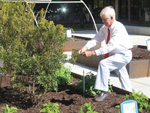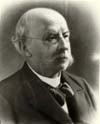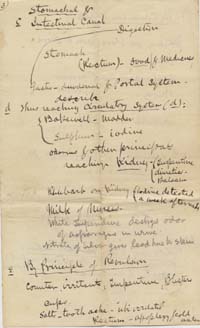|
by Dawn Brazell
Public Relations
Green must run in the
blood of the Porcher family.
It's only fitting that the hands of
Richard Porcher, Ph.D., helped landscape
the eight flowering beds of MUSC's Porcher
Medicinal Garden that opened Oct. 18.
Porcher realized his tie to Francis Peyre
Porcher, M.D., for whom the garden is
named, when he was in graduate school
pursuing an interest in zoology. He took a
field botany course and fell in love with
the subject. He also learned about his
ancestor, born in 1824, and the
contributions he made, including authoring
the book, "Resources of the Southern
Fields and Forests."
 Dr.
Richard Porcher helps prepare the beds
in the medicinal garden. Dr.
Richard Porcher helps prepare the beds
in the medicinal garden.
"All of a sudden, I realized I had a
botanist background," he said, adding that
he has loved being involved in picking
plants for the garden. Porcher, a noted
field biologist himself and former
professor of biology at The Citadel, is a
member of the Waring Library Society's
board of directors.
"I think the garden is fantastic. Finally,
people will have an idea of the
contributions he [Francis Porcher] has
made," he said. He appreciates that the
garden will be a living tribute to his
ancestor and credits MUSC President Ray
Greenberg, M.D., Ph.D., and Susan Hoffius,
curator of the Waring Historical Library,
for making it a reality.
"It's a fascinating piece of history. With
the garden, it all comes full circle in
seeing how those plants are being used
today."
Hoffius said she likes that connection as
well. "It's exciting to reintroduce
someone from our past to people today. The
talent he had was indisputable. He was a
botanist and he came from a long line of
botanists. It sort of ran in his blood. He
took that interest and knowledge of local
flora and made it applicable in a medical
setting."
Though Porcher's book was written during
Civil War time to help Southerners who
were suffering from the lack of medical
supplies available, Porcher had a longer
view of its use beyond the immediate needs
of the Confederates. Not all the book is
directed at medicinal uses either, she
said. It's like an almanac of sorts with
directions for everything from making lye
soap and dyes from plants to producing
brandy.
The germ of the idea for the medicinal
garden came from the landscape architect,
Bill Eubanks (of Urban Edge Studio in
Mount Pleasant), of the Drug Discovery
Building who recommended it as a nice
addition. Greenberg loved the idea and
wanted to tie it into MUSC's history.
"He wanted to make the connection to Dr.
Porcher and looking at our future with the
Drug Discovery Building and looking for
new drugs and new therapies. This garden
is a tribute to what we have always done,
which is to innovate medicine. We were
doing that in 1863 when this book came out
with Dr. Porcher, and we're still doing it
today. One hundred fifty years ago we had
faculty members who were making really
significant contributions to pharmacology
and medical therapies, and we still do. I
think that's a nice connection."
The garden features more than 40 specimens
that are shown in Porcher's book including
signage with botanical information as well
as details about what the plants were used
for. There also is a companion website
with more information about the plants. It
will list the entry it had in his book,
and for those who want to know modern-day
uses, there will be a link to its entry in
the Natural Medicine Compendium database,
a pharmacy resource that Wayne Weart,
PharmD, arranged for MUSC's use.
Horsemint
Butterflyweed
Monkshood
There's a leadership team that will
oversee the garden composed of people from
a variety of fields, including
pharmacology, history and horticulture
with programming opportunities being
handled by the Office of Health Promotion.
There will be garden tours,
lunch-and-learn events and educational
sessions for students. "It will be a
nicely balanced group of people looking at
the garden from various perspectives, not
just as a garden or a healing garden. It's
the pharmaceutical and the horticultural
part, the history. It's all of it
together," Hoffius said. Her hope is that
the garden will be an inspiration.
Bitterbloom
Indian Pink
Jimson weed
The botanical illustrations above by
Thomas Hamm are on display with the art
of Linda Ann Vinson at the Drug
Discovery Building as part of a special
exhibition "The Flowering of Medicine."
"It's to say, 'look at the things around
us that are untapped as of now.' We should
not discard something out of hand just
because we're unfamiliar with them."
She refers to a botanical illustration of
horsemint that is part of "The Flowering
of Medicine," a special exhibition of
illustrations by Thomas L. Hamm and Linda
Ann Vinson that's being displayed in the
Drug Discovery Building in conjunction
with the garden dedication.
"I went to the beach
and saw a field of this horsemint. I would
have thought someone needs to get out the
mower, but now I see it in a different
light. What I've learned is that all of
these weeds that I've walked by millions
of time have these properties above and
beyond themselves. They're not just weeds.
They have value."
It's a value students
and researchers can see in using the
garden as an educational resource,
including the historical materials in the
Waring Library and the online website
resources. Not everyone who comes to the
garden will care about the medicinal part,
though, and that's just fine, she said.
"My favorite thing
about it would be if it's used by a
variety of people for a variety of
reasons, sort of like art. You can get as
much as you want from it. It has a living
presence and an inspirational presence,
whether that inspiration is peacefulness
and natural harmony or whether it's
research or healing."
Porcher Medicinal
Garden
Where: Facing the Drug
Discovery Building between the Colbert
Education Center & Library and the
Basic Science Building
Website: http://waring.library.musc.edu/exhibits/PMG/about.php
Artwork Exhibition: "The
Flowering of Medicine" being shown at the
Drug Discovery Building, the botanical
features illustrations of Thomas Hamm and
Linda Ann Vinson.
For more info: Visit the
website or contact the Office of Health
Promotion, 792–1245.
 Dr. Francis Peyre
Porcher, 1824 - 1895 Dr. Francis Peyre
Porcher, 1824 - 1895
These handwritten
notes from Francis Porcher at the Waring
Historical Library are part of a
collection of his papers available to
students and faculty for research.
Contact the library at 792-2288 for more
information. 
Did You Know?
- Francis Peyre
Porcher was born at Ophir Plantation in
St. John's, Berkeley County, South
Carolina on Dec. 14, 1824 to Dr. William
and Isabella Sarah Peyre Porcher.
- Through his mother's
side, he was a descendant of the
well-known English botanist Thomas
Walter, author of Flora Caroliniana, the
first catalog of the flowering plants of
South Carolina published in 1788.
- Porcher graduated
from the Medical College of the State of
South Carolina. He was first in his
class of 76, in 1847. His thesis, A
Medico-Botanical Catalogue of the Plants
and Ferns of St. John's, Berkeley, South
Carolina, was published later that same
year by the faculty of the Medical
College.
- During his long
affiliation with the Medical College,
Porcher served as professor of clinical
medicine and chair of materia medica,
which he held from 1874 to 1891. With
fellow Medical College alumnus Julian J.
Chisolm (1830-1903), Porcher opened a
hospital specifically for the care of
plantation slaves.
- At the outbreak of
the Civil War, Porcher joined the
Confederate Army as a surgeon to South
Carolina's Holcombe Legion and was then
transferred to the Naval Hospital at
Norfolk, Va. in March 1862. He
finished his Confederate service in the
South Carolina Hospital at Petersburg,
Va.
- While in Virginia,
Porcher was "released temporarily from
service in the field and hospital" by
Confederate States Surgeon General
Samuel Preston Moore to write,
"Resources of the Southern Fields and
Forests." The handbook identified local
plants with therapeutic qualities that
could be used not only by Confederate
surgeons, but planters and farmers, in
place of manufactured drugs made
unavailable because of the Union
blockade of Southern ports and the lack
of southern pharmaceutical laboratories.
The handbook written in 1863 was of such
value that a revised edition was
published in 1869.
- Four editions of the
manual were produced during the course
of the war and are now available for
research use at the Waring Historical
Library.
- When the war ended,
Porcher returned to Charleston and
resumed his academic positions at the
Medical College. As his
professional career thrived and he
received many honors, he remained a
prolific contributor to the medical
literature and wrote on a variety of
topics including yellow fever, diseases
of the heart, typhoid and malaria.
- After suffering a
paralytic stroke, Porcher died at his
home in Charleston, on Nov. 19, 1895.
- Porcher's papers are
housed at the Waring Historical Library,
which has digitized them for research
use.
Friday, Oct.
26, 2012
|



 Dr.
Richard Porcher helps prepare the beds
in the medicinal garden.
Dr.
Richard Porcher helps prepare the beds
in the medicinal garden. Dr. Francis Peyre
Porcher, 1824 - 1895
Dr. Francis Peyre
Porcher, 1824 - 1895